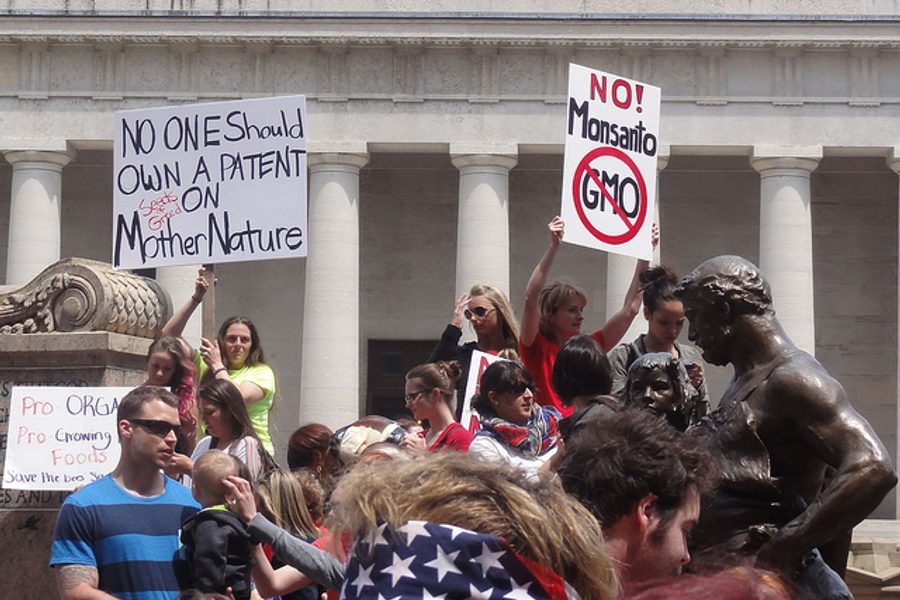
By conventional wisdom it was excellent news. Researchers at Iowa State University demonstrated in 2012 that organic farming methods can produce yields almost as high as pesticide-intensive methods. Other researchers, at the University of California — Berkeley, reached a similar conclusion. Indeed, both findings met with an enthusiastic reception. The enthusiasm is appropriate, but only if one misses a deep and fundamental point: that even to participate in such a conversation is to fall into a carefully laid trap.
The strategy of Monsanto’s PR — and that of about every major commercial participant in the industrialized food system — is to promote a single overarching big idea: that only industrial producers in the food system can produce enough for the world’s future population.
To be sure, agribusiness has other PR strategies, such as claiming agribusiness is “pro-science” and its opponents are “anti-science,” but the main plank has for decades been to create a cast-iron moral frame around the need to produce more food.
If you go to the websites of Monsanto, Cargill, Syngenta, Bayer and their bedfellows, they immediately raise the “urgent problem” of who will feed the expected global population of 9 or 10 billion in 2050.
Likewise, whenever these same organizations compose speeches or press releases, or videos, or make any pronouncement designed for policymakers or the populace, they hype the same urgent problem. It is their Golden Fact, their universal calling card. And as far as people who are unfamiliar with the issue are concerned it wins the food system debate hands down, because it says, if any other farming system cannot feed the world, it is irrelevant. Only agribusiness can do that.
Yet this strategy has a disastrous foundational weakness. There is no global or regional shortage of food. There never has been and nor is there ever likely to be. India has a superabundance of food. South America is swamped in food. The United States, Australia, New Zealand and Europe are overflowing with food. In Britain, like in many wealthy countries, nearly half of all row crop food production now goes to biofuels, which are in essence a scheme to dispose of surplus agricultural products. China isn’t quite as overwhelmed with food, but it still produces enough to export and grows 30 percent of the world’s cotton. No foodpocalypse there either.
Even some establishment institutions will occasionally admit that the food shortage concept — now and in any reasonably conceivable future — is bankrupt. According to experts consulted by the World Bank Institute there is already sufficient food production for 14 billion people—more food than will ever be needed. The Golden Fact of agribusiness is, at bottom, a lie.
Truth Restoration
If the agribusiness PR experts are correct that fomenting food crisis fears are pivotal to their industry, then it follows that those who oppose the industrialization of food and agriculture should make dismantling that lie their top priority.
Anyone who would like to rebuild the rural economy or who appreciates cultural, biological or agricultural diversity should take every possible opportunity to point out the evidence that refutes this lie. Granaries are bulging, crops are being burned as biofuels or dumped, prices are low, farmers are abandoning farming for slums and cities, all because of massive oversupply. Even just to speak of crop yield as an issue (for anyone other than the individual farmer who sometimes places importance on yield), is to reinforce the framing of the industry.
The project to fully industrialize global food production is far from complete, yet already it is responsible for most deforestation, most marine pollution, most coral reef destruction, much of greenhouse gas emissions, most habitat loss, most of the degradation of streams and rivers, most food insecurity, most immigration, most water depletion, massive human health problems and so on. Our planet is becoming literally uninhabitable largely as a result of the social and ecological consequences of industrializing agriculture. And all these problems come on top of Big Ag’s trillions of dollars in annual externalized costs and subsidies.
So, if one were to devise a strategy for the food movement, it would be this. The public already knows (mostly) that pesticides are dangerous. They also know that organic food is higher quality, and is far more environmentally friendly. They know that GMOs are largely untested and may be harmful. The immense scale of the problems created by industrial agriculture can always be explained better, but the main facts are hardly in dispute.
But what industry understands, and the food movement does not, is that what prevents total rejection of bland, industrialized, pesticide-laden, GMO food is the standard acceptance, especially in Western countries, of the overarching agribusiness argument that such food is necessary. It is necessary to feed the world.
But, if the food movement could show that famine is an empty threat, then it would also have shown, by implication, that the chemical health risks and the ecological devastation that these technologies represent are unnecessary. Therefore, every project of the food movement should aim to spread the truth of oversupply, until mention of Big Ag’s Golden Fact invites ridicule and embarrassment rather than fear.
Divide and Confuse
Food campaigners might also consider that combatting the food scarcity myth can unite a potent mix of causes. Just as an understanding of food abundance destroys the argument for pesticide use and GMOs, it also creates the potential for common ground within and between constituencies that do not currently associate much: health advocates, food system workers, climate campaigners, wildlife conservationists and international development campaigners.
The food crisis lie has led many members of these constituencies to ignore what could be the best solution to their mutual problems: small scale farming and pesticide-free agriculture. This is exactly what Big Ag intended. So divisive has the Golden Fact been that some nonprofits have entered into perverse partnerships with agribusiness while others support inadequate or positively fraudulent sustainability labels.
Another consequence has been mass confusion over the observation that almost all the threats to the food supply (salinization, water depletion, soil erosion, climate change and chemical pollution) come from the supposed solution — the industrialization of food production.
When the smoke is blown away and the mirrors are taken down, the current food system leaves us with two clear choices.
Down one path lie family farms and ecological methods. These support farmer and consumer health, resilience, financial and democratic independence, community, cultural and biological diversity, and long term sustainability. Down the other is control of the world’s food system by corporate agribusiness. Agribusiness domination leads invariantly to dependence, uniformity, poisoning and ecological degradation, inequality, land grabbing, and, not so far off, to climate chaos.
One is a vision, the other is a nightmare: in every single case where industrial agriculture is implemented it leaves landscapes progressively emptier of life. But for obvious reasons those who profit from it cannot allow all this to become broadly understood. That is why the food scarcity lie is so fundamentally important to them.
Reverse PR?
Companies and industries pay huge sums of money for Public Relations (PR), which is predicated on the idea that all human behavior is governed by belief systems. PR involves, first, discovery of the structure of those belief systems, mainly through focus groups, and, second, the subsequent manipulation of those belief structures with respect to particular products or other goals.
The food and environmental movements, however, have never seriously contested this manipulated reality of a food crisis by the public relations industry. Yet in the age of the internet it is no longer necessary to let an industry decide where the truth resides. It is now possible to restore reality to the global discussion about food so that all potential production methods can have their merits fairly evaluated. But until this happens agribusiness and chemical industry solutions will always be the default winner and alternative agriculture will always be the alternative, if it exists at all.
Power, Lies, and Consent
The evidence with which to contradict the lie is everywhere; but in an unequal and unjust system truth never speaks for itself. We must unembed ourselves from the web of industry thinking.
To refute the food scarcity lie requires that we do two things. First, we must refuse to be intimidated by the torrents of misinformation and learn the basic facts of the food system. Second, we must shift our perceptions by moving beyond physical goals — such as saving individual species or achieving specific political ends — and toward understanding the underlying mental state of the citizenry.
Anyone who desires social change on a significant scale should realize not only that corporations and others deliberately engineer social change, but that when they do so their first step is reordering the “reality” perceived by the people. In other words, an industry’s PR apparatus first creates a reality (such as food scarcity) for which their desired change appears to the public as obvious, beneficial or natural. When the solution comes, people not only don’t resist it, but indeed may welcome it.
As in most wars, the crucial struggle in the food war is the one inside people’s heads. The side that best understands this fact and uses it will win.
The natural advantages of the grassroots in this realm are many. First, the power of the Internet represents a historic opportunity to connect with others. Second, it takes a lot less effort to assert the truth than it does to structure a lie — after all, people only need to hear the truth once. Third, in this particular battle the nonprofit, public-interest side doesn’t necessarily need a bigger megaphone because, unlike the industry, nonprofits are (broadly) trusted by the public.
Consequently, it is perfectly possible that a lie that took several powerful industries many decades to build up could be dismantled in months. We need only to unleash the power of the truth and to remember the hidden power of the people: a power whose strength is reflected in all the effort and resources that corporations pour into misleading them.
It is all in the mind.
(A version of this story first appeared on IndependentScienceNews.org and is reposted here with permission.)








